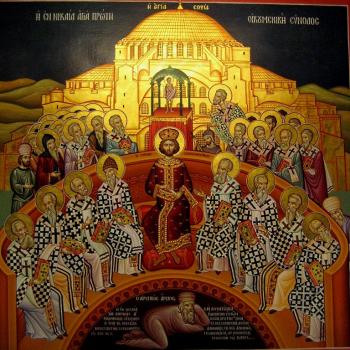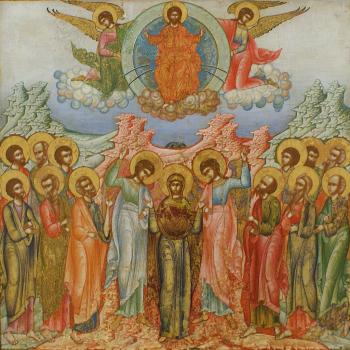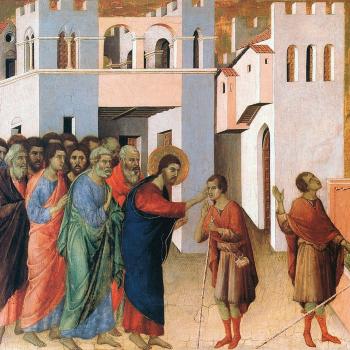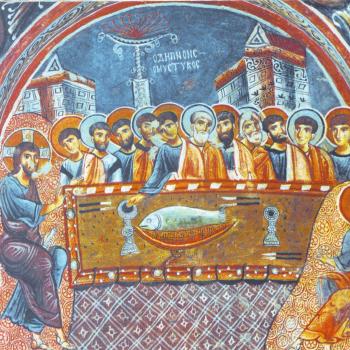
Scripture shows us that the God-Man, Jesus, the Logos become flesh, has appeared, and continues to appear, to his creation in a variety of forms. First, it gives us the various Theophanies in the Tanakh. Here, it is the pre-incarnate Logos coming to and reaching out to humanity (especially the people of Israel). Then there is Jesus living out his historical mission. Likewise, there is the glory of the Transfigured Jesus (which was seen before his death and resurrection); in this form, Peter, James and John saw Jesus interacting with Moses and Elijah. We also have the various forms of the resurrected Jesus, such as the one encountered on the road to Emmaus, or the form which Paul saw and heard on the road to Damascus. There are the various apocalyptic forms represented by John. Then, when Jesus is seen in the breaking of the bread, we have his eucharistic form. There is the form of Jesus found within every Christian thanks to their baptism. And finally, Jesus is found in those who are in need.
Not everyone is capable of perceiving Jesus in each of his various forms. But, in each form, those who do perceive Jesus are called out by him to reveal what they learn from him. For we are all called to be his witnesses according to the way we perceive him. In this way, we continue the work of the early apostles, who talked about how they only revealed the truth of their experiences to others: “For we did not follow cleverly devised myths when we made known to you the power and coming of our Lord Jesus Christ, but we were eyewitnesses of his majesty” (2Ptr. 1:16 RSV).
As not everyone was capable of encountering him in every one of his forms in the Apostolic age, we should not be surprised if not everyone can and will perceive him in every form today. We should seek to encounter Jesus, to become witnesses of him in his glory. We should recognize the many forms, the many ways Jesus can come to meet us, realizing that he does so with skill and precision, coming to us in a way in which we are ready to meet with him and learn from him. Each form is truly him, though some forms represent his glory, his splendor greater than others. As those who come out of a darkness to the bright light of the day need to adjust in order to see properly in the light, so we, coming out of the darkness of sin, need to find ourselves adjusting to the healthy spiritual light Jesus established for us in order to perceive him in his glorified form. But, until we do, we can encounter him in Scripture, in the eucharist, and indeed, in our neighbor, and if we let ourselves be transformed by that encounter, we shall slowly find ourselves to be like Peter, James, and John who climbed Mt. Tabor and witnessed the transcendent glory of the Son of God.
Origen explains this well in his many writings. We encounter Jesus in many forms, each of them must truly be said to be him, each of them related to and one with each other, and yet each of them representing a different aspect of who he is to us.[1] Thus, in his Commentary on Matthew, Origen points out that we first begin to see Christ as an uncomely slave (thanks to what sin has done to us), but when we become perfected in Christ, we encounter him as the glory of the Father:
But if you will understand the differences of the Word which by “the foolishness of preaching” is proclaimed to those who believe, and spoken in wisdom to them that are perfect, you will see in what way the Word has the form of a slave to those who are learning the rudiments, so that they say, “We saw Him and He had no form or beauty.” But to the perfect He comes “in the glory of His own Father,” who might say, “and we beheld His glory, the glory as of the only-begotten from the Father, full of grace and truth.” For indeed to the perfect appears the glory of the Word, and the only-begotten of God His Father, and the fullness of grace and likewise of truth, which that man cannot perceive who requires the “foolishness of the preaching,” in order to believe.[2]
Origen shows how this is represented in the Transfiguration; those who followed Jesus to the height of the mountain were able to perceive him in his glory, while those who were left behind still only saw him in the form of a servant as they were themselves still merely servants:
But you will ask if, when He was transfigured before those who were led up by Him into the lofty mountain, He appeared to them in the form of God, in which He formerly was, so that He had to those below the form of a servant, but to those who had followed Him after the six days to the lofty mountain, He had not that form, but the form of God. [3]
Thus, while we must affirm the unity of Jesus, that Jesus is but one person, this does not mean he cannot and does not have many forms. He does. He approaches people and relates to them where they are at:
Although Jesus was only a single individual, He was nevertheless more things than one, according to the different standpoint from which He might be regarded; nor was He seen in the same way by all who beheld Him. Now, that He was more things than one, according to the varying point of view, is clear from this statement, “I am the way, and the truth, and the life;” and from this, “I am the bread;” and this, “I am the door,” and innumerable others. And that when seen He did not appear in like fashion to all those who saw Him, but according to their several ability to receive Him, will be clear to those who notice why, at the time when He was about to be transfigured on the high mountain, He did not admit all His apostles (to this sight), but only Peter, and James, and John, because they alone were capable of beholding His glory on that occasion, and of observing the glorified appearance of Moses and Elijah, and of listening to their conversation, and to the voice from the heavenly cloud.[4]
Not all are capable of perceiving Christ in his glorified form. To those who are, Christ reveals himself in it. To others, he keeps to his simpler, kenotic form, which he likewise controls to such an extent, that even it can appear differently to various people (which is why Judas had to point Jesus out to the authorities so they could arrest him), as Grillmeier explains:
The difference in the way in which Christ was seen lay not merely subjectively on the side of men, in their mind and in their perceptual abilities of body and soul, but also objectively, in an actual variation in the bodily appearances of Jesus. For Origen, the proof of this lies in the necessity of the kiss of Judas. [5]
Finally, Christ gives himself to others according to both their ability and or their need. Sometimes, the ability is there, but the need is not. Sometimes the need is there, but the ability is not. Through grace, he can elevate people (like Paul) so that they can then perceive him in his glory and share it with others. Nonetheless, this helps us understand why, if we encounter him in his glory, we might not always see him in that form:
And be not surprised if all the multitudes who have believed on Jesus do not behold His resurrection, when Paul, writing to the Corinthians, can say to them, as being incapable of receiving greater matters, “For I determined not to know anything among you, save Jesus Christ, and Him crucified;” which is the same as saying, “Hitherto you were not able, neither yet now are you able, for you are still carnal.” The Scripture, therefore, doing everything by appointment of God, has recorded of Jesus, that before His sufferings He appeared to all indifferently, but not always; while after His sufferings He no longer appeared to all in the same way, but with a certain discrimination which measured out to each his due. And as it is related that “God appeared to Abraham,” or to one of the saints, and this “appearance” was not a thing of constant occurrence, but took place at intervals, and not to all, so understand that the Son of God appeared in the one case on the same principle that God appeared to the latter. [6]
Thus, we find a tradition, represented by Origen, explaining how and why Jesus is revealed to us in many forms. The historical form represents the basic encounter between God and humanity through the incarnation, but even then, as the stories in Scripture indicate, this form was not always recognizable to his enemies and they needed help in finding him (such as in the Garden of Gethsemane). As the Transfiguration indicates, the glorified form, the glorified presence, is always there, but only rarely is it encountered. We must be careful, here, and not just assume that after the resurrection, the glorified body represents the same glory as found in the Transfiguration. The earthly body is transformed into glory, but behind this transformed earthly body, there remains various levels of transcendent glory (such as the glory of the Transfiguration), and those who are prepared for them will be able to see them.
This might seem like a strange way to understand Jesus. Realizing that he has many forms at once might seem as if Jesus is divided. But the point is that the glory of the kingdom of God is great, indeed always ever greater than where we are at now, that in its infinite transcendence, and so it can and will reveal itself in many forms and ways according to our capabilities. This realization is not just a Christian realization. We find, around the same time Origen, Buddhists coming to realize something similar with the Buddha. In Mahāyāna Buddhism, we have the development of the Trikāya doctrine, the teaching of three various forms or bodies of the Buddha, explaining the various ways a Buddha is said to engage his followers. Yogācāra (or Cittamātra or Vijñānavāda) Buddhism systematized what came before it, establishing three kinds of forms: the Essence Body, the Enjoyment Body, and the Transformation Body:
The excellence of wisdom is to be understood as the three bodies of the Buddha, which are the Essence body, the Enjoyment body, and the Transformation body. Among these, the Essence is the Dharma body of Tathāgatas, because it is the support for mastering all things. The Enjoyment body is the body that is manifested in the various Buddha lands and the experience of delight in the doctrine of the Great Vehicle. The Transformation body is also supported upon the Dharma body because it manifests itself [in many perceptible manners] such as residing in and descending from the Tuṣita palace, being born [in Kapilavastu], undertaking learning, indulging in desire for the material world, leaving home, going to the infidels’ place, practicing asceticism, attaining perfect awakening, turning the wheel of the Doctrine, and entering into final cessation.[7]
The Essence Body (or Dharma Body) is the foundation and base for the other bodies; it is who or what a Buddha is in essence, that is, the dharma in its pure emptiness:
The Cittamātra tradition generally speaks of the Buddha possessing three bodies. The first is referred to as either the dharmakaya or the svabhāvikakāya – the Essence or Essential Body. These are two ways of referring to the same thing, although from different angles. The same body is said to be the dharmakaya, because it is the support of dharma, and the Essence Body because it is self-contained and does not contain anything contingent or adventitious. [8]
The Enjoyment Body, the Saṃbhogikakāya, is a Buddha as seen in a pure land, full of glory; not all are capable of encountering or experiencing this form of the Buddha. Rather, those of great spiritual power and ability, such as bodhisattvas, are able to perceive a Buddha in this form, and receive from him higher training:
The second is [the body] for the enjoyment of others. As a result of the knowledge of sameness, Tathāgatas manifest bodies of subtle, pure qualities and abide in a thoroughly pure land. For the hosts of bodhisattvas on the ten stages, they manifest great supernatural powers, turn the Wheel of the True Dharma, and rend the nets of the multitude of doubts, causing [bodhisattvas] to enjoy the joy of Mahayana Dharma. [9]
It is also in this form that a Buddha has its most normative form for devotion, as Paul Williams explains:
The Enjoyment Body is in many respects the most important body of the Buddha (Nagao 1973; esp. 33ff). It is the actual Buddha in his supramundane form, normally said to be the Buddha of Buddhist devotion, a transcendent being animated through pure compassion. [10]
Finally, there is the Transformation Body, the Nirmāṇikakāya, which a Buddha creates in time and space to be able to be witnessed by people of little to no spiritual inclination and meet with them and begin to train them so that they can start their spiritual transformation. Siddhārtha Gautama represents the transformation body of the historical Buddha. People who learn of it, or who meet with him, are given foundational lessons on the dharma. Likewise, a Buddha can manifest himself into history in many ways, so it is not just one historical form, but many, meeting people where they are at. The goal is to help everyone onto the right spiritual path; then, when they are spiritually developed, they will be able to encounter the Buddha in his Enjoyment Body and receive greater lessons from him. Likewise, a Buddha is acting in and through both his Enjoyment Body and the Transformation Body at the same time; this is how Mahāyāna Buddhism explains their own particular sūtras: while the Buddha was giving beginning lessons in his Transformation Body, he was also giving higher, greater lessons to the myriad of spiritual beings who could perceive him in his Enjoyment Body, and those higher lessons are what are recorded in many of the Mahāyāna texts.
In this fashion, it is said that the form of a Buddha which someone encounters is in part, dependent upon the character and quality of the person in question. A Buddha, a Tathāgata knows what is needed, and through skillful means, engages people according to their potential: “It is also said that a Tathāgata’s knowledge of achieving the task creates the three actions [of body, speech, and mind]. It is also said that the transformation [created by the Tathāgata] has a mind that is dependent on others, because a seen part of consciousness appears that it dependent on another real mind. “[11]
Likewise, it is said that the Enjoyment Body and the Transformation Body should be understood as “impermanent,” and empty, according to basic Mahāyāna understanding of the terms. [12] And that emptiness demonstrates the truth of the Essential Body.
This systematic Buddhist representation of the Buddha can be of use to us as we try to understand the various forms of Christ. While the context is different, and we must take that into account, it seems as if the seeds of the Logos, spread throughout the world, have given Buddhist philosophers a way to understand the various ways in which the Logos comes to us in history and in glory. Just as a Buddha is said to be teaching people in his historical manifestation as well as to spiritually advanced people in his glorified form, so we can see Jesus, the Logos, manifesting himself in both forms even in his earthly ministry. Moses and Elijah, like Peter, John, and James, serve as witnesses to the glorified form of the Logos; the Law and the Prophets, through Moses and Elijah, are shown to come not just from the simple historical form of Christ but rather his glorified form and so should be respected as presenting transcendent truths.
The truth which is found in the Law and the Prophets is the truth that is revealed in and through the economy of the incarnation. It is the same truth. Behind both forms lies the greater, transcendent truth which makes each form of the truth true and indeed, participants in the fullness of truth. The same, to be sure, can be said about the eucharist form of Jesus. We truly have the Jesus with us in the eucharist, but here, Jesus comes to us in the form of spiritual food and drink, revealing to us through them our need for communion with him. It is the same Jesus as the Jesus found in history. It is the same Jesus as seen in heaven. It is the same Jesus who knows how to come to us in forms which we need. We need to do more than believe in Jesus. We need to do more than believe his words. We need to open ourselves up to him and join ourselves to him.
We might want to pitch a tent and stabilize Jesus in the form which we already recognize and understand, such as his historical form. But we must not do so. We must open ourselves up to the spirit of truth and not just be caught up in the way it is currently manifested to us and limit the truth to that manifestation. For we risk turning the truth against itself if we reify the form of truth which we can presently encounter. If we are capable of accepting the greater glory, the greater truth which lies behind the form of the truth which we can currently perceive, then the form of the truth which we recognize presents the truth to us. It points to us beyond the external form and to the truth itself. The key is to realize that Jesus can be and is met by us in different forms, and though we start with the lowest form ( such as his historical form), we should seek to follow after him so we can encounter him in his glorified form (and learn from him in that encounter) and then seek to further unite with him until we are raised to meet him in the purity of his essence (represented by the mystic as theosis).
[1] See Aloys Grillmeier, Christ in Christian Tradition: From the Apostolic Age to Chalcedon (451). Trans. J.S. Bowden (New York: Sheed and Ward, 1965), 82.
[2] Origen, “Commentary on Matthew” in ANF(9): 466 [Book XII.30]
[3] Origen, “Commentary on Matthew,” 470 [Book XII.37]
[4] Origen, “Against Celsus” in ANF(4): 457 [II.64].
[5] Aloys Grillmeier, Christ in Christian Tradition: From the Apostolic Age to Chalcedon, 83.
[6] Origen, “Against Celsus” in ANF(4): 458 [II.66].
[7] Asaṅga, The Summary of the Great Vehicle. Trans. John P. Keenan (Berkley, CA: Numata Center for Buddhist Translation and Research, 1992), 105.
[8] Paul Williams, Mahāyāna Buddhism: The Doctrinal Foundations (London: Routledge, 1989), 175.
[9] Hsüan-tsang, Demonstration of Consciousness Only in Three Texts on Consciousness Only. Trans. Francis H. Cook Berkley, CA: Numata Center for Buddhist Translation and Research, 1999), 361.
[10] Paul Williams, Mahāyāna Buddhism: The Doctrinal Foundations, 178.
[11] Hsüan-tsang, Demonstration of Consciousness Only, 364.
[12] While an important point, it would go far beyond our interests here to explain Buddhist concepts of emptiness.
Stay in touch! Like A Little Bit of Nothing on Facebook.
If you liked what you read, please consider sharing it with your friends and family!












